Book contents
- Spatial Analysis Methods and Practice
- Reviews
- Spatial Analysis Methods and Practice
- Copyright page
- Contents
- Preface
- 1 Think Spatially
- 2 Exploratory Spatial Data Analysis Tools and Statistics
- 3 Analyzing Geographic Distributions and Point Patterns
- 4 Spatial Autocorrelation
- 5 Multivariate Data in Geography
- 6 Modeling Relationships
- 7 Spatial Econometrics
- References
- Index
6 - Modeling Relationships
Regression and Geographically Weighted Regression
Published online by Cambridge University Press: 20 May 2020
- Spatial Analysis Methods and Practice
- Reviews
- Spatial Analysis Methods and Practice
- Copyright page
- Contents
- Preface
- 1 Think Spatially
- 2 Exploratory Spatial Data Analysis Tools and Statistics
- 3 Analyzing Geographic Distributions and Point Patterns
- 4 Spatial Autocorrelation
- 5 Multivariate Data in Geography
- 6 Modeling Relationships
- 7 Spatial Econometrics
- References
- Index
Summary
This chapter deals with
Linear regression notions and mathematical formations
The assumptions that a linear regression model is based on
Identifying linear relationships between a dependent variable and independent variables
Residual plots, leverage and influential points
Evaluate the degree (effect) to which one variable influences the positive or negative change of another variable
The geometrical interpretation of the intercept and the slope, and various metrics and tests used to assess the quality of the results
The interpretation of coefficients
Studying casual relationships (under specific conditions)
Building a predictive model by fitting a regression line to the data
Evaluating the correctness of the model
Model overfitting
Ordinary least squares (OLS)
Exploratory OLS
Geographically weighted regression (GWR)
After a thorough study of the theory and lab sections, you will be able to
Distinguish which regression method is more appropriate for the problem at hand and the data available
Interpret statistics and diagnostics used to evaluate a regression model
Interpret the outcomes of a regression model such as the coefficient estimates, the scatter plots, the statistics and the maps created
Identify if relationships, associations or linkages among dependent and independent variables exist
Analyze data through regression analysis in Matlab
Conduct exploratory regression analysis in ArcGIS
Conduct geographically weighted regression in ArcGIS
Keywords
- Type
- Chapter
- Information
- Spatial Analysis Methods and PracticeDescribe – Explore – Explain through GIS, pp. 351 - 450Publisher: Cambridge University PressPrint publication year: 2020



